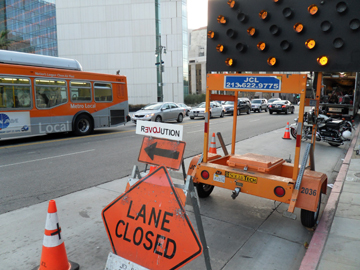
At the edge of the Occupy LA encampment, at City Hall. Photo: Carol Cheh.
As I write this, I am nearing the end of a battery of holiday get-togethers. These affairs tend to be filled with people that you only see once a year—relatives both close and distant, old family friends, childhood acquaintances. We gather around parties and shared meals and try to find some common ground for conversation. Yesterday I found myself chatting with a worker’s comp lawyer and a former corporate ladder climber, now turned zen gardener. Corporate politics and the machinations of the economy were hot topics.
I briefly touched on my life in “the art world,” which always brings faraway gazes touched with unfamiliarity and, sometimes, a bit of envy. As the art person, I’m always the odd woman out at gatherings like this. My world is perceived as a luxury/fantasy world that doesn’t interconnect in meaningful ways with the worlds of business, finance, law, the military—worlds inhabited by the majority of people in our society. In America, the art world is, for the most part, its own bubble—filled with specific people, who have a specific shared passion, and speak a specific language. Like queer people and people with eccentric hobbies, we have to find each other in order to survive, in order to perpetuate our way of life.
Having been deeply involved in the art world for the past 10 years, I’ve become acutely aware of the segregation of “art” and “life” in this country. Somewhere along the line—most likely amidst the loud noise of a relentless capitalist engine that promotes a severe work ethic and a concomitant valuation of economic competition and material rewards—American appreciation for the arts has been diminished to the point of near invisibility. Unlike many nations whose histories significantly predate the industrial revolution, Americans have never considered the arts an integral part of daily, ordinary life. At best, it’s a nice luxury that we can afford when times are good. At worst, it’s something that freaks and weirdos do, and of course, it’s first on the chopping block when times get tough.
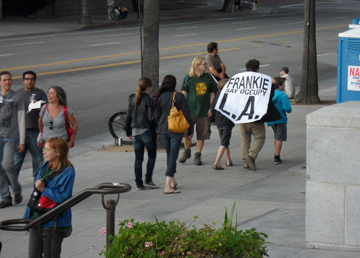
Protesters at Occupy LA. Photo: Carol Cheh.
Occupy Los Angeles
The Occupy movement ignited in the city of Los Angeles on October 1, 2011, when a group of protesters took up residence on the grounds of City Hall. The movement was met with passion and enthusiasm right away, and grew with astonishing speed. By Day 9, they had set up a welcome tent, food service, media station, first aid tent, and numerous other facilities. Volunteers were giving tours of the grounds. The number of tents in residence kept multiplying, until there was no available lawn space left.
I visited the encampment a total of about six times before it was shut down in a surgical strike-style police raid on the morning of November 30. Every time I went, the vibe changed, the logistics of the place shifted. It was an extremely dynamic community, reflecting the struggle of a broad spectrum of discontented people to birth a new movement that was full of unknown quantities. The issues that gave rise to the movement—economic and social inequity, and the bankruptcy of a system that rewards greed at the expense of greater societal health—were absolutely real, and their urgency was palpable. But in this initial outburst of a broad-scale response, there was the sense that people weren’t exactly sure what they were doing—they were just doing it.
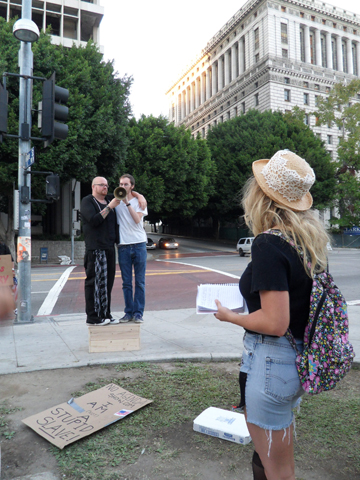
Artist Solomon Bothwell, center, sets up a soap box and encourages passers-by to voice their grievances. Photo: Carol Cheh.
The fertile, permeable Occupy LA space had the ability to accommodate a freewheeling variety of people, causes, ideas, and activities. In this environment I saw, probably for the first time in my life, a place where art, political activism, and day-to-day life could co-exist with equal agency and equal weight. Artists created a huge mural in the center of the park that indicted the Federal Reserve Bank as a monstrous octopus sucking the life out of the people. Painters offered up images of Gandhi and Anonymous for contemplation. Acts of performance and social practice happened everywhere, on a daily basis, both small-scale and large-scale, both announced and spontaneous. Political action and artistic practice blended seamlessly, beautifully, together—and there was no one around to get didactic about it!
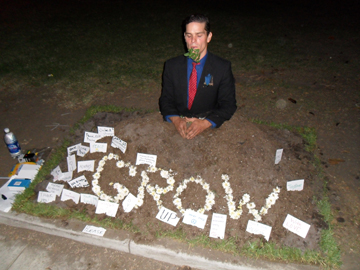
Performance action at Occupy LA, artist's name unknown. Photo: Carol Cheh.
Even when I participated in the Queer Nation and ACT UP protests of the 1990s, I did not witness this kind of matter-of-fact incorporation of art, politics, and life. The queer protests of that era were sharply focused, creatively choreographed, and highly effective. But they still constituted a distinct, segregated space. I remember with amusement meeting one other queer Asian woman who shared the same interest in the arts as I did. We vowed to form an Arts Caucus, but never did. There was an agenda to adhere to, and it kept us busy.
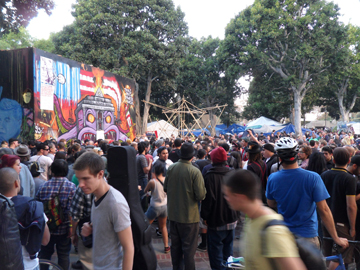
A huge crowd gathers at Occupy LA in anticipation of an imminent police shutdown. Photo: Carol Cheh.
Some may view the Occupy movement’s nebulousness as a disadvantage. But I see the movement as an opening salvo in what is no less than an attempt at total, fundamental change of the way things are. As such, it must be inclusive of everything and everyone, particularly those parts of our society that were previously shut out or denigrated.
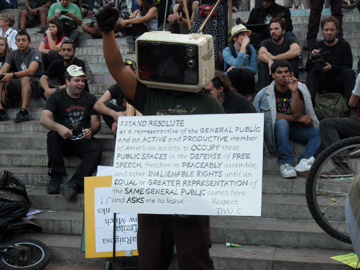
Performance action on the steps of City Hall, artist's name unknown. Photo: Carol Cheh.
In one local radio broadcast, I heard a woman say, in response to criticism that the Occupy movement lacked concrete demands: “We do not demand anything, for that is the position of the powerless. Instead, we are modeling a whole new way of being.”
In this tentative, inchoate, experimental utopia—which was by no means free of its own discords and controversies—artistic practice was not a far-flung branch of the tree, which could be cut off at the first sign of rot. Rather, it was an inherent part of its root system, which grew and moved right along with it.
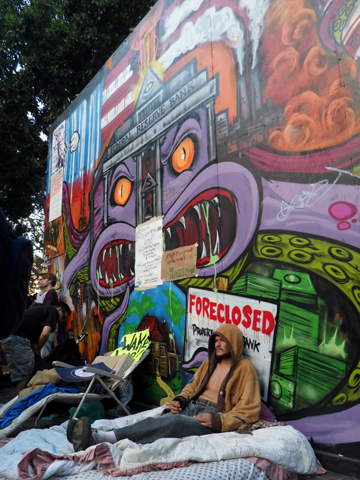
Mural at the center of the Occupy LA encampment. Photo: Carol Cheh.
#OccupyArt21
From the beginning, I and many artists that I know from the local LA community have been strongly aligned with Occupy LA. Some of us have spent significant amounts of time there, participating in the general assemblies and on committees. Some have combined their time on site with their own artistic practices, which encompass performance, experimental music, and social practice. Others have shown up to do specific actions. Still others have participated via social media, the internet, and thinking constantly about the issues.
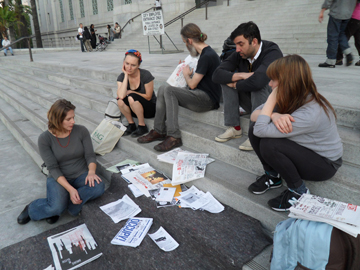
Artist Nancy Popp, left, shares materials and information from her trip to New York, in which she networked with Occupy Wall Street participants. Photo: Carol Cheh.
We’ve held a few general meetings as a group, and we even have a website, a Facebook group, and an email list. Rather than being a highly organized, branded entity, however, we are more a loosely affiliated collection of individuals whose actions are spontaneous and organically conceived. People propose actions through the aforementioned outlets and interested parties can sign up to participate. Anyone can drop in or out at any time, participate live or via social media/Ustream, with no judgment or expectations. This is actually more satisfying to me than more strident, focused models. Because it means again, that art flows freely from life for once, that it is not a separate designation or an agenda item, it is just something that occurs naturally as part of being at or in alignment with Occupy LA, which in its City Hall encampment phase was also known as Solidarity Park.
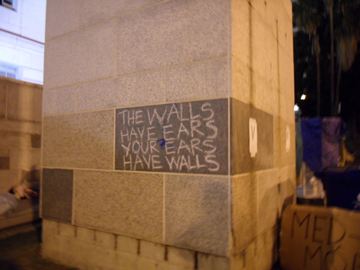
A wall on the north lawn of City Hall, shortly before the Occupy LA encampment was shut down. Photo: Carol Cheh.
The blog posts by various artists and writers that will occupy this guest spot for the next two weeks reflect just a small sampling of the talent and intelligence at work in the Occupy LA movement. Each contribution has its own individual genius, but all share a rigorous and seamless blending of the visual and the aesthetic with sociopolitical awareness, critique, and activism. I am so proud to be a part of this.
Carol Cheh is a writer and curator based in Los Angeles. She is the founder of Another Righteous Transfer!, a blog that explores LA’s performance art scene. Her curatorial projects have included You Don’t Bring Me Flowers: An Evening of Re-Performances (PØST, 2010) and Signals: A Video Showcase (Orange County Museum of Art, 2008).




Pingback: #OccupyArt21 | AAAAAA